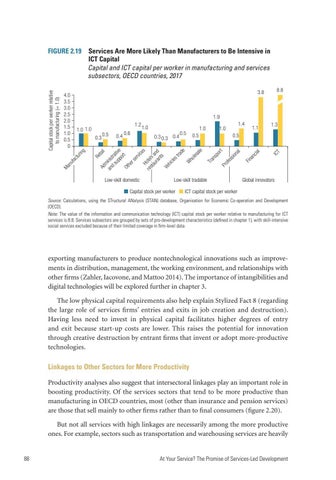1.9 0.5
0.4
1.0 0.3 0.3 0.4
0.5
1.0 0.5
Low-skill domestic
1.4
1.0
1.3
0.5
Low-skill tradable
Capital stock per worker
1.1
ICT
0.3
0.6
Fin an cia l
1.0 1.0
Tr an sp ort Pr ofe ss ion al
1.2
Re tai Ad l mi n an is d s tra up tive po rt Ot he rs er vic es Ho res tel tau s a ran nd ts Ve hic les tra de W ho les ale
nu Ma
8.8
3.8
ing
4.0 3.5 3.0 2.5 2.0 1.5 1.0 0.5 0
fac tur
Capital stock per worker relative to manufacturing (= 1.0)
FIGURE 2.19 Services Are More Likely Than Manufacturers to Be Intensive in ICT Capital Capital and ICT capital per worker in manufacturing and services subsectors, OECD countries, 2017
Global innovators
ICT capital stock per worker
Source: Calculations, using the STructural ANalysis (STAN) database, Organisation for Economic Co-operation and Development (OECD). Note: The value of the information and communication technology (ICT) capital stock per worker relative to manufacturing for ICT services is 8.8. Services subsectors are grouped by sets of pro-development characteristics (defined in chapter 1), with skill-intensive social services excluded because of their limited coverage in firm-level data.
exporting manufacturers to produce nontechnological innovations such as improvements in distribution, management, the working environment, and relationships with other firms (Zahler, Iacovone, and Mattoo 2014). The importance of intangibilities and digital technologies will be explored further in chapter 3. The low physical capital requirements also help explain Stylized Fact 8 (regarding the large role of services firms’ entries and exits in job creation and destruction). Having less need to invest in physical capital facilitates higher degrees of entry and exit because start-up costs are lower. This raises the potential for innovation through creative destruction by entrant firms that invent or adopt more-productive technologies.
Linkages to Other Sectors for More Productivity Productivity analyses also suggest that intersectoral linkages play an important role in boosting productivity. Of the services sectors that tend to be more productive than manufacturing in OECD countries, most (other than insurance and pension services) are those that sell mainly to other firms rather than to final consumers (figure 2.20). But not all services with high linkages are necessarily among the more productive ones. For example, sectors such as transportation and warehousing services are heavily 88
At Your Service? The Promise of Services-Led Development

